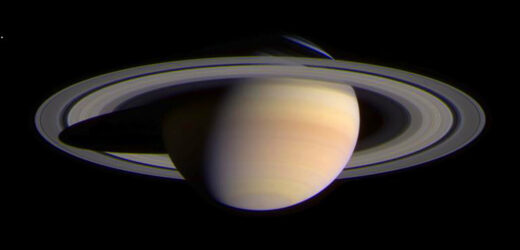Saturn’s icy rings are not just aesthetically wondrous marvels. One of them also records a beautiful planetary soundtrack.
The planet’s interior, concealed beneath a shroud of mostly hydrogen gas, convulses. This causes shifts in the local gravity field, which pulls at particles in Saturn’s expansive C ring and makes them dance. These idiosyncratic prances can take the form of spiral waves, and distinct sets of waves reveal the characteristics of particular features of Saturn’s insides.
Put another way, Saturn is an orchestra. Different notes are showing up on the C ring, like those on sheet music. Scientists can read these notes, hear the music and identify the individual instruments and musicians performing — all without ever seeing the orchestra itself.
Using data from the Cassini mission that ended in 2017, scientists have listened to and deconstructed a variety of symphonies in Saturn’s C ring over the years. Now, two researchers from the California Institute of Technology — Christopher Mankovich, a planetary scientist, and Jim Fuller, a theoretical astrophysicist — have decoded enough of this music to hear the sounds of one of Saturn’s most puzzling features: its core.
According to their paper, published on Monday in the journal Nature Astronomy, the core is colossal: It makes up 60 percent of the planet’s radius and is 55 times the mass of Earth. And unlike the ordered solid clump of metallic, rocky or icy matter found within other worlds, Saturn’s core is a pandemonious amalgam of assorted rocks and ices mingling with a fluid metallic form of hydrogen. The findings bring researchers closer to understanding how Saturn — and other gassy behemoths like it, including Jupiter — was born.
100 Images From Cassini’s Mission to Saturn
NASA’s Cassini spacecraft burned up in Saturn’s atmosphere on Friday, after 20 years in space.
“It’s a very beautiful story,” said Linda Spilker, the project scientist for the Cassini mission at NASA’s Jet Propulsion Laboratory, who was not involved with the work.
The geologic viscera of Earth, the moon and (most recently) Mars were mapped out with seismometers, instruments that record the journeys of seismic waves moving through the planet and behaving differently as they traverse through mechanically different layers. Saturn, lacking a solid surface, makes this sort of detective work impossible.
Orbiting spacecraft can roughly map out a gassy planet’s internal layer cake structure by detecting subtle changes in gravity. But Saturn’s core has such a weak effect on the planet’s gravitational field that this trick cannot be used to precisely visualize it.
Fortunately, the shimmying of Saturn’s C ring has unveiled what traditional techniques cannot. Over the past three decades, scientists have been observing the ring’s strange spiral waves through imagery from both the Voyager missions and Cassini. And they ultimately reasoned that those spirals are being caused by gargantuan oscillations within Saturn.
“They’re just constant quakes that exist everywhere on the planet,” Dr. Mankovich said.
It is a technique known as “kronoseismology”: “kronos” being the Greek word for Saturn, and “seismo” pertaining to shakes. In 2019, it was used to solve another puzzle: How long is a day on Saturn? (About 10 and a half Earth-hours.)
Now Saturn’s core has been illuminated. Older models depicted the planet as if it were a distinctly layered cosmic jawbreaker candy. Kronoseismology has revealed the messy truth. The core is made up of not only rock and ice but also fluid metallic hydrogen, which was previously assumed to be a separate layer. There is more rock and ice at its center, and more fluid metallic hydrogen at its outer edges — but, throughout, everything is mixed in a chaotic cocktail. Along with the transitionary change from fluid to gassy hydrogen higher up, this paper paints Saturn as one big fuzzy ball.
Despite the technique’s continued success, scientists still don’t know what is causing the core to oscillate and create those spiral waves in the C ring. Earth resonates like a bell when it is rocked by powerful tectonic temblors. “But Saturn is fluid, so where are the quakes?” asked Mark Marley, a planetary scientist at the University of Arizona and an early trailblazer of kronoseismology who was not involved with the work.
The orchestra’s musicians may finally be known, but the hunt for its elusive conductor continues.
Source: Read Full Article



